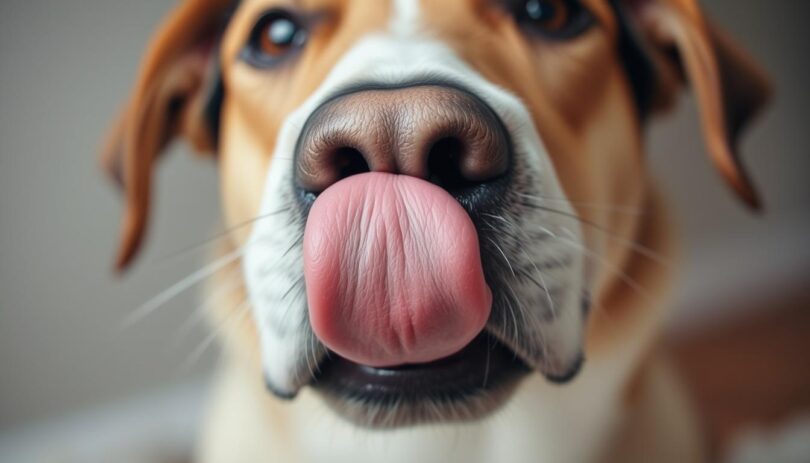You’ve probably seen your furry companion smacking their mouth after a meal or during playtime. But when those quick tongue flicks turn into constant lip-licking, it’s natural to feel concerned. This common behavior can mean many things – from harmless anticipation to silent cries for help.
Occasional mouth movements are normal, especially if your pet smells food or feels excited. However, repeated motions might signal hidden problems. Dental pain, stomach discomfort, or anxiety often manifest through this subtle body language. Recognizing the difference between “I’m hungry” and “I’m hurting” could be vital for your companion’s well-being.
This guide explores physical triggers like tooth decay or nausea, along with emotional factors such as stress. You’ll learn practical strategies to address each scenario, from vet visits to calming techniques. We’ll also share tips to prevent future issues through routine care and observation.
By understanding why pets display this behavior, you’ll gain confidence in supporting their health. Let’s decode those quiet signals together and ensure your four-legged friend stays happy and comfortable.
Understanding Canine Lip Licking Behavior
Most pet owners recognize that quick tongue flick when their four-legged friend hears the treat bag rustle. Occasional lip movements are part of normal communication and self-grooming. However, persistent actions often carry hidden messages that require attention.
Normal Behavior vs. Concern
Brief lip motions during meals or play typically signal harmless anticipation. A pet might lick their mouth after tasting new food or when excited about a walk. These short-lived gestures mirror human habits like tapping fingers while waiting.
Frequent repetitions—especially without obvious triggers—warrant closer observation. If the behavior continues for hours or disrupts daily activities, it could indicate nausea or oral pain. Watch for patterns: Does it spike during thunderstorms or after chewing certain toys?
Identifying Additional Stress Signals
Yawning, excessive drooling, or avoiding eye contact often accompany anxiety-driven lip motions. Some pets turn their heads away or pace nervously. These calming signals help animals manage overwhelming situations.
Track timing and surroundings. Occasional motions near dinner time? Normal. Constant licking paired with panting during vet visits? Likely stress. Documenting these details helps owners distinguish between quirks and cries for help.
Health Issues That May Cause Your Dog to Lick Lips
If your companion repeatedly touches their tongue to their muzzle, hidden physical discomfort could be the trigger. Persistent motions often point to oral distress or systemic health problems needing attention. Observing accompanying symptoms helps pinpoint the root cause.
Dental Discomfort and Oral Pain
Plaque buildup and cracked teeth often irritate gums, making pets swipe their paws across their mouths. Foreign objects like bone fragments or grass seeds lodged between molars worsen the discomfort. Excessive drooling or reluctance to chew toys may signal these issues.
Untreated tartar hardens into calculus, creating pockets where infections thrive. Annual dental cleanings remove debris and spot early signs of decay. Left unchecked, gingivitis can progress to painful abscesses requiring extraction.
Nausea, Dehydration, and Underlying Illnesses
Upset stomachs from eating spoiled food or sudden diet changes increase saliva production. Pets lick their mouths to manage this excess fluid. Motion sickness during car rides or kidney disease also triggers similar reactions.
Dehydration thickens saliva, prompting frequent tongue movements to moisten dry gums. Chronic conditions like diabetes or liver problems may cause this. If lip motions pair with vomiting or lethargy, schedule a vet visit immediately.
Tracking patterns helps separate minor indigestion from serious illnesses. Most cases resolve with hydration or dietary adjustments, but recurring episodes demand professional evaluation.
Behavioral and Environmental Triggers for Lip Licking
Dogs often communicate through subtle gestures, with their mouth movements revealing emotional states. Environmental changes and daily routines can spark this behavior, ranging from harmless excitement to anxiety-driven responses. Understanding these contexts helps owners respond appropriately.
Stress Signals and Soothing Actions
Loud noises or unfamiliar guests often trigger displacement behaviors. A pet might repeatedly touch their tongue to their muzzle during thunderstorms or when meeting new people. This self-soothing action helps manage nervous energy, similar to humans fidgeting during tense moments.
Stress activates saliva glands, creating a moist mouth that prompts frequent motions. Construction sounds or schedule changes can initiate this cycle. Watch for flattened ears or tucked tails alongside mouth movements – these paired signals confirm unease.
Mealtime Anticipation and Excitement
The clink of a food bowl often sparks enthusiastic tongue flicks. This Pavlovian response mirrors how humans might salivate smelling fresh cookies. Brief motions before meals or walks are normal, especially in food-motivated breeds.
Differentiate excitement from distress by timing. Does the behavior stop once food arrives? Excitement fades quickly, while anxiety lingers. Create calm feeding routines by waiting until your pet sits quietly before serving meals.
Reduce environmental stressors with designated quiet zones containing familiar blankets or toys. Gradually expose pets to triggering sounds using positive reinforcement. Consistent routines and patient training help balance emotional responses.
Practical Tips for When dog keeps licking lips
Addressing repetitive tongue flicks requires a mix of observation and action. Start by tracking when and where the behavior occurs. Note environmental triggers like loud noises or schedule changes. This data helps tailor solutions to your companion’s specific needs.
Home Remedies and Calming Techniques
Create a quiet retreat using blankets or a covered crate during stressful events. Interactive toys like puzzle feeders redirect focus from anxiety to food rewards. Frozen broth cubes or chew sticks provide mental stimulation while keeping the mouth occupied.
Hydration stations with fresh water ease dry gums linked to dehydration. Gentle gum massages with pet-safe toothpaste improve oral comfort. Weekly tooth brushing reduces plaque buildup that might irritate sensitive areas.
When to Consult Your Vet
Schedule an appointment if the behavior persists beyond 48 hours or pairs with vomiting, diarrhea, or appetite changes. Yellowish gums, swollen jaws, or bleeding require immediate attention. Blood tests and dental X-rays often uncover hidden health issues.
Minor incidents during thunderstorms or car rides usually resolve with comfort measures. However, recurrent episodes signal deeper problems. Trust your instincts – proactive care prevents minor concerns from becoming major challenges.
Preventive Measures and Daily Care for Lip Licking
Preventing excessive mouth motions begins with consistent care routines. Simple daily habits reduce health risks while strengthening your bond with your furry companion. Let’s explore strategies that address both physical comfort and emotional well-being.
Building Healthy Habits
Brush your pet’s teeth three times weekly using enzymatic toothpaste. This removes food particles before they harden into plaque. Pair this with dental chews approved by the Veterinary Oral Health Council to maintain gum health.
Schedule bi-annual vet checkups to catch hidden issues early. Professionals spot cracked teeth or gum inflammation during routine exams. Bloodwork identifies systemic conditions like kidney disease that might trigger lip licking.
Create calm environments with designated rest areas away from noisy appliances. Rotate interactive toys to prevent boredom-related stress. For anxious pets, try pheromone diffusers or compression wraps during thunderstorms.
Adjust diets gradually over 7-10 days to avoid stomach upset. High-fiber foods and probiotics support digestion, reducing nausea-linked behaviors. Always provide fresh water in multiple locations to prevent dehydration.
Proactive care minimizes triggers while enhancing overall wellness. These steps help pets feel secure, letting their natural behaviors shine through without excessive mouth movements.
Wrapping Up Your Canine Lip Licking Concerns
Understanding your pet’s silent signals helps create a happier home. Lip licking can stem from simple excitement or hidden health needs. Quick motions around mealtime often show anticipation, while repeated patterns might indicate dental discomfort or stress.
Watch when and how often it happens. Brief mouth movements during play? Normal. Constant motions paired with drooling or avoidance? Time to investigate. Combine your observations with the strategies shared—like dental checkups and stress-reducing environments—to address root causes effectively.
Most pets thrive with consistent care routines. Regular vet visits catch early warning signs, while daily tooth brushing prevents oral issues. Remember, occasional licks require no action, but persistent behavior deserves attention.
Trust your instincts as a pet parent. If concerns linger after trying home solutions, schedule a professional evaluation. Your informed care transforms those quiet tongue flicks into opportunities for deeper connection and better health.
FAQ
Is frequent lip licking always a sign of illness?
Not necessarily. Occasional lip licking can be normal, like during meals or grooming. However, persistent or sudden increases in this behavior, especially paired with drooling or appetite changes, may indicate underlying health or stress issues.
Could dental problems cause my pet to smack its lips often?
Yes. Oral pain from gum disease, broken teeth, or foreign objects stuck in the mouth often leads to excessive lip licking. Bad breath, reluctance to eat hard food, or pawing at the face are common red flags requiring a veterinary exam.
How does anxiety trigger this behavior?
Stressful situations—like loud noises, new environments, or conflicts with other animals—can cause displacement behaviors such as lip licking. Look for additional stress signals like flattened ears, yawning, or avoidance to confirm anxiety as the trigger.










Leave a Comment